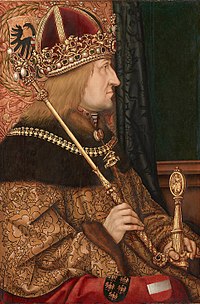Our website is made possible by displaying online advertisements to our visitors.
Please consider supporting us by disabling your ad blocker.
Holy Roman Emperor
| Emperor of the Romans | |
|---|---|
| Imperator Romanorum Kaiser der Römer | |
Imperial | |
 | |
 | |
| Details | |
| First monarch | Charlemagne (AD 800 formation) Otto the Great (AD 962 formation) |
| Last monarch | Francis II |
| Formation | 25 December 800 |
| Abolition | 6 August 1806 |
The Holy Roman Emperor, originally and officially the Emperor of the Romans (Latin: Imperator Romanorum; German: Kaiser der Römer) during the Middle Ages, and also known as the Roman-German Emperor since the early modern period[1] (Latin: Imperator Germanorum; German: Römisch-Deutscher Kaiser), was the ruler and head of state of the Holy Roman Empire. The title was held in conjunction with the title of King of Italy (Rex Italiae) from the 8th to the 16th century, and, almost without interruption, with the title of King of Germany (Rex Teutonicorum, lit. 'King of the Teutons') throughout the 12th to 18th centuries.[2]
The Holy Roman Emperor title provided the highest prestige among medieval Catholic monarchs, because the empire was considered by the Catholic Church to be the only successor of the Roman Empire during the Middle Ages and the early modern period. Thus, in theory and diplomacy, the emperors were considered primus inter pares, regarded as first among equals among other Catholic monarchs across Europe.[3]
From an autocracy in Carolingian times (AD 800–924), the title by the 13th century evolved into an elective monarchy, with the emperor chosen by the prince-electors. Various royal houses of Europe, at different times, became de facto hereditary holders of the title, notably the Ottonians (962–1024) and the Salians (1027–1125). Following the late medieval crisis of government, the Habsburgs kept possession of the title (with only one interruption) from 1440 to 1806. The final emperors were from the House of Habsburg-Lorraine, from 1765 to 1806. The Holy Roman Empire was dissolved by Francis II, after a devastating defeat by Napoleon at the Battle of Austerlitz.
The emperor was widely perceived to rule by divine right, though he often contradicted or rivaled the pope, most notably during the Investiture controversy. The Holy Roman Empire never had an empress regnant, though women such as Theophanu and Maria Theresa exerted strong influence. Throughout its history, the position was viewed as a defender of the Catholic faith. Until Maximilian I in 1508, the Emperor-elect (Imperator electus) was required to be crowned by the pope before assuming the imperial title. Charles V was the last to be crowned by the pope in 1530. Even after the Reformation, the elected emperor was always a Catholic. There were short periods in history when the electoral college was dominated by Protestants, and the electors usually voted in their own political interest.
- ^ Cite error: The named reference
German-Romanwas invoked but never defined (see the help page). - ^ Peter Hamish Wilson, The Holy Roman Empire, 1495–1806, MacMillan Press 1999, London, p. 2. Erik von Kuehnelt-Leddihn: The Menace of the Herd or Procrustes at Large – p. 164. Robert Edwin Herzstein, Robert Edwin Herzstein: "The Holy Roman Empire in the Middle Ages: universal state or German catastrophe?"[year needed][page needed]
- ^ Terry Breverton (2014). Everything You Ever Wanted to Know About the Tudors but Were Afraid to Ask. Amberley Publishing. p. 104. ISBN 978-1-4456-3845-4.
Previous Page Next Page
Römisch-deutscher Kaiser ALS إمبراطور روماني مقدس Arabic امبراطور رومانى مقدس ARZ Müqəddəs Roma imperatoru AZ موقدّس روم ایمپیراتورو AZB Імпэратары Сьвятой Рымскай імпэрыі BE-X-OLD Император на Свещената Римска империя Bulgarian Sacre emperador romanogermànic Catalan Císař říše římské Czech Ymerawdwr Glân Rhufeinig CY


